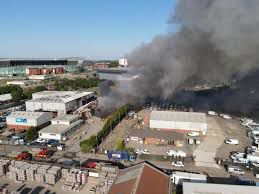

In one of the most tragic and devastating events in the history of Scottish football, a fire broke out at Celtic Park, home of Celtic Football Club, claiming 101 lives and leaving 432 others injured. This catastrophic incident has sent shockwaves through not only the football community but the entire nation. As details emerge, it becomes evident that the tragedy could have been avoided if proper safety measures had been in place.
This article delves into the heart-wrenching details of the fire, the lack of safety protocols that led to the disaster, and the aftermath for the victims, the club, and the broader footballing world. While no words can truly capture the enormity of this event, understanding what went wrong is a crucial step toward ensuring that such a tragedy never occurs again.
The Incident: A Night of Horror
It was an ordinary matchday at Celtic Park when the unimaginable happened. As thousands of fans filled the stadium, excited for the upcoming game, none could have predicted the nightmare that would unfold. The fire started in one of the stadium’s older sections, reportedly in a part of the structure that had not been adequately modernized to meet current safety standards.
The fire rapidly spread through the stands, fueled by flammable materials in the older areas of the stadium. Panic set in almost immediately, with fans scrambling to escape the smoke-filled stands. Emergency exits, though present, were not easily accessible due to overcrowding, and the stadium’s design made it difficult for many to find their way to safety in the chaos.
The fire raged for what felt like an eternity, consuming sections of the stands and causing immense fear and confusion among fans and staff. The rapid spread of the flames was exacerbated by a lack of proper fireproofing and outdated electrical systems that had not been updated to meet modern safety standards.
By the time the fire was finally brought under control, 101 people had lost their lives, and 432 more were injured, some critically. The majority of those affected were fans who had come to watch the match, but many staff members and emergency responders were also injured as they worked to rescue individuals from the inferno.
The Investigation: Lack of Proper Safety Measures
In the aftermath of the disaster, an extensive investigation was launched to determine the cause of the fire and to assess the factors that contributed to such an enormous loss of life. Initial reports suggest that several key safety protocols were ignored or inadequately addressed, contributing to the high casualty count and severe injuries.
Outdated Fire Safety Systems: One of the primary causes identified in the investigation is the outdated fire safety measures within Celtic Park. While the stadium had fire alarms and sprinklers, the systems were not sufficiently modernized to deal with the scale of the fire. Many of the systems had not been properly tested or maintained in recent years. Experts have suggested that if these safety systems had been up to date, the fire might have been contained much earlier, potentially saving many lives.
Inadequate Evacuation Plans: Another contributing factor was the stadium’s evacuation plan, which was woefully inadequate for a large-scale emergency like the one that occurred. Eyewitnesses reported that panic quickly spread through the crowd, and many fans had difficulty finding their way out of the stadium due to blocked or congested exits. The evacuation routes were not clearly marked, and in some cases, doors that were meant to open outward to facilitate an easy exit were either blocked or malfunctioning
Overcrowding: Reports suggest that the stadium was operating at full capacity for the match, which, in itself, may not have been a problem. However, when the fire broke out, the overcrowded conditions made evacuation even more difficult. Crowds surged toward the exits, causing bottlenecks that slowed down the evacuation process and trapped many individuals in areas that were rapidly filling with smoke.
Failure to Conduct Regular Safety Inspections: There were also concerns raised about the lack of regular safety inspections at Celtic Park. In the years leading up to the fire, there had been growing concerns about the state of the stadium’s infrastructure, especially in some of its older sections. While minor repairs were carried out, there were no major refurbishments to address these growing concerns. The lack of comprehensive safety checks meant that issues such as faulty wiring, inadequate fire barriers, and the risk of flammable materials accumulating in older parts of the stadium went unnoticed until it was too late.





